Microsoft Surface Pro 3 Review
by Anand Lal Shimpi on June 23, 2014 3:55 AM ESTBattery Life
Microsoft made no sacrifice in battery capacity in pursuit of Surface Pro 3's thin chassis design. The new tablet features an integrated 42Wh battery just like the previous two models. Charging duties are handled by an external 31W charger with a brand new magnetic connector. Microsoft never seemed to get a good MagSafe clone working in the previous models, so Surface Pro 3 abandons the previous design entirely in favor of something a bit more sensible.
The new connector no longer looks like an oversized MagSafe connector, and instead features a thin plastic insert that mates with the charge port on Surface Pro 3. Charge time hasn't changed, you can fully charge the device in around 2.62 hours:
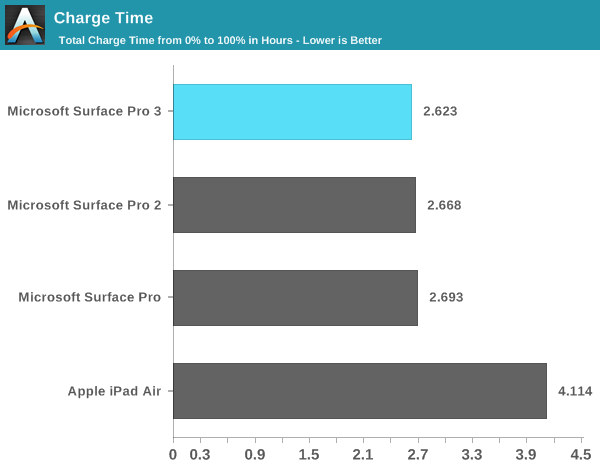
The device-side connector features 40 pins but you only need 12 of them to charge the device. The remaining pins are used for Gigabit Ethernet, USB, DisplayPort (up to 4096 x 2304) and audio. Microsoft seems hell bent on avoiding Thunderbolt at all costs so instead of embracing the standard it has created a custom alternative of its own doing. The benefit to Microsoft's connector is it can obviously deliver more power than Thunderbolt can, the downside is that it can't send PCIe and thus you don't get support for any ultra high bandwidth external storage devices. I still would rather see Microsoft implement Thunderbolt as there's at least an existing ecosystem built around that but here we are three generations into Surface and if we haven't seen it by now I don't think we're ever going to.
The supplied power adapter includes a USB charge port capable of delivering 1A at 5V.
As Surface Pro 3 is designed to be both a laptop and a tablet I've run it through both our Windows laptop battery life tests and our tablet battery life tests.
Laptop Battery Life
As a laptop, Surface Pro 3 delivers comparable battery life to other optimized Haswell ULT designs. I threw in Sony's Vaio Pro 13 into the mix because it has a similar sized battery (37Wh vs. 42Wh) and is one of the most power efficient Windows Ultrabook platforms on the market. Surface Pro 3 manages to deliver similar battery life, which means it's a little less power efficient but the two are within the same range at least.
Compared to Surface Pro 1 and 2, Surface Pro 3 at worst delivers similar battery life and at best increases range on a single charge by up to 20%. We're looking at 3.75 hours - 7.6 hours of notebook usage on a single charge depending on usage.
It's worth noting that there's a substantial advantage in battery life if we look at the 13-inch MacBook Air running OS X. I only mention this because of Microsoft's insistence on comparing Surface Pro 3 to Apple's popular line of notebooks.
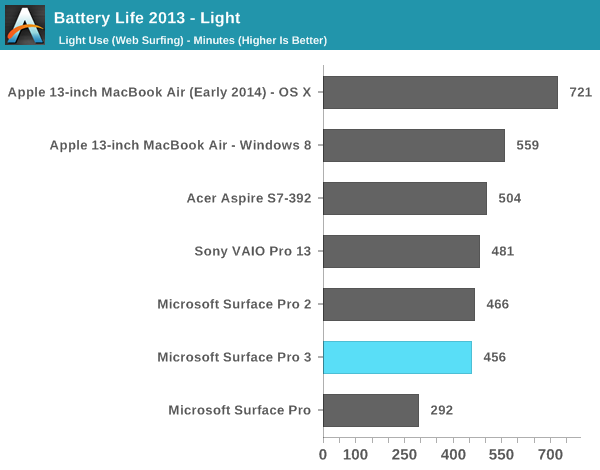

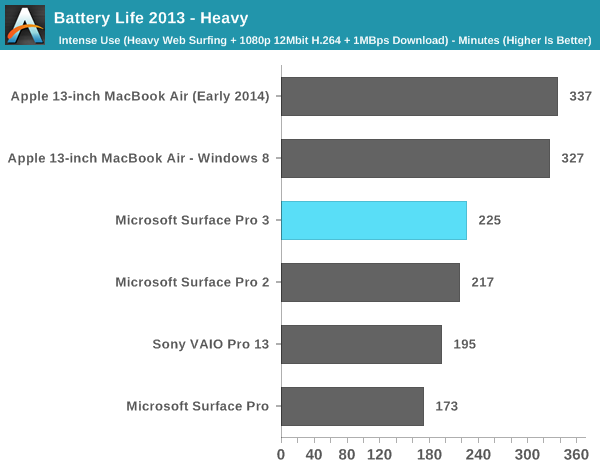
Tablet Battery Life
Tablet workloads are going to be far more display power bound than anything else. Here we see 7.58 - 8.03 hours of continuous usage, a slight regression compared to Surface Pro 2. Video playback remains more power hungry than web browsing, which is something I've noted in previous tablet-evaluations of Intel's Core silicon. I don't believe Intel's Core processors are very optimized for video decode power consumption. If anything is going to change with the move to Broadwell and Core M I suspect video decode power may be it.
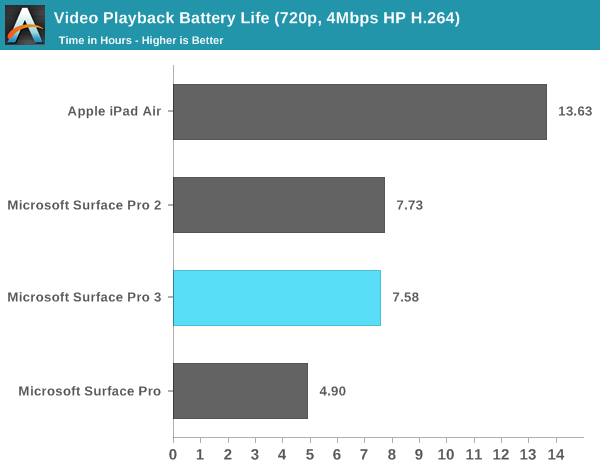
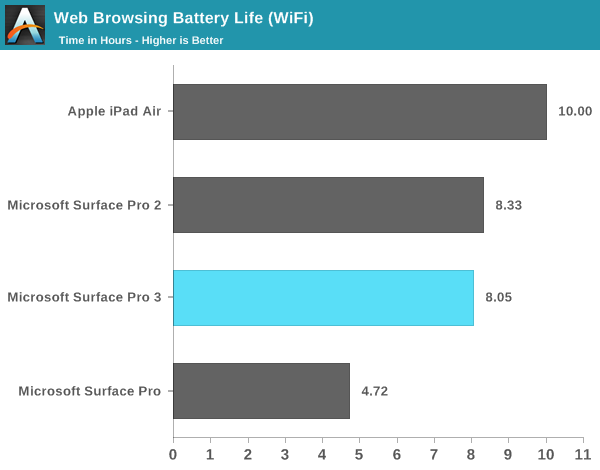


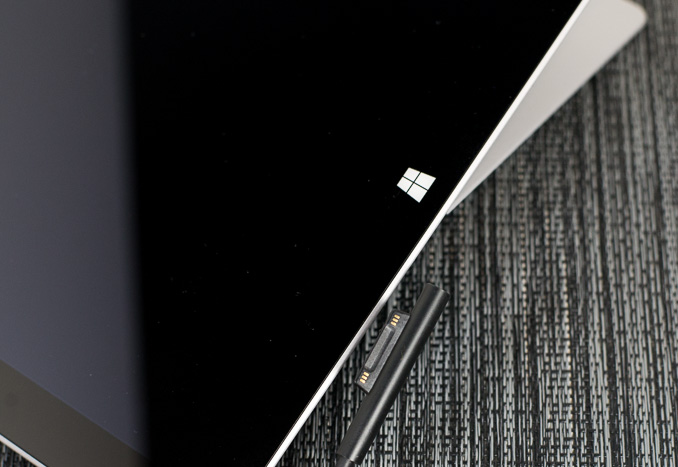
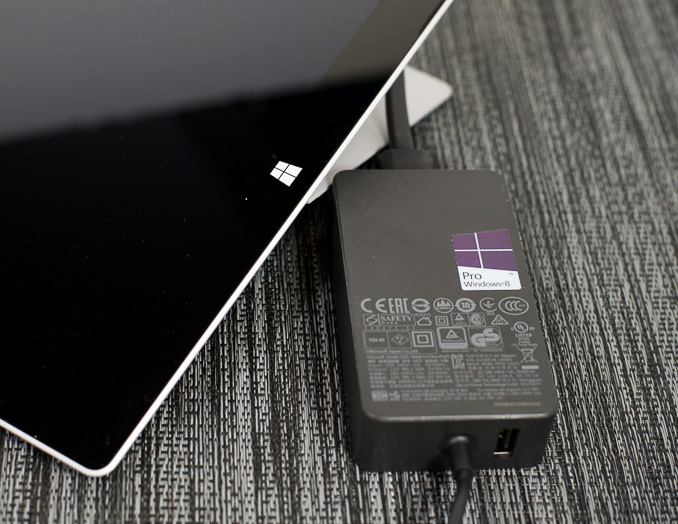








274 Comments
View All Comments
Walkop - Wednesday, September 17, 2014 - link
Edit: never , I see you meant now.Walkop - Wednesday, September 17, 2014 - link
Stupid Chrome Beta and gesture keyboards… *never mind, *see whatWalkop - Wednesday, September 17, 2014 - link
No.The Surface Pro's aspect ratio gives it a bigger display area than both MacBook Air's.
Sabresiberian - Monday, June 23, 2014 - link
I don't understand why you need a comparison written as an article. You are certainly capable of doing it for yourself - and have. :)Tegeril - Monday, June 23, 2014 - link
"TypeCover=1095g" when Macbook Air 11 is 108x grams but represented in kg suggests some sort of odd agenda, if you ask me.drmyfore - Tuesday, June 24, 2014 - link
Surface Pro 3 / 7.6V 42.2Whr 5547mAhMacbook Air 11 / 7.6V 38.75Whr 5100mAh
Macbook Air 13 / 7.6V 54.4Whr 7150mAh
Obviously, in battery life test, the MBA 11 is more appropriate than MBA 13.
name99 - Tuesday, June 24, 2014 - link
I think the more interesting comparison is with iPad Air.Basically (depending on the details) it's 2 to 3x as fast, with 3x tending to kick in when hyper threading is useful. How long does that advantage last?
The speed bump from A5 to Swift was about 2x, split between about 1.6x frequency improvement and 1.2x µarchitecture improvement. This accompanied a 45 to 32nm process change.
Swift to Cyclone was about a 1.5x improvement, all in architecture and µarchitecture, with a minor process improvement (32nm to 28nm HK).
A8 is expected to be a substantial process improvement (20nm, but still not FinFet). Personally I think this round the big changes will be in an Apple branded graphics cell and in the uncore, with minor changes in the core, but from process we should expect about a 1.5x boost, with obvious frequencies being 1.8 or 2GHz. So with the A8 round Apple does not hit Haswell, but gets a lot closer. Of course we then get Broadwell, but we expect Broadwell to be what, a 1.1x speedup or so?
IF Apple decides this is the year to switch to three cores rather than 2 that gives us a further factor of 1.5x (for that fraction of benchmarks that are substantially parallel) and we get even closer.
I'm on the fence about whether this makes sense yet, but Apple tends to design for products that stay relevant for 4yrs or so; and if they believe they're going to achieve substantially more parallelism over the next 4 yrs, it may make sense to do this now. They may also feel the marketing pressure is becoming problematic given the supposed China love of extra cores. They may also, this round, give us an A8X variant for iPads with three cores, keeping the phone A8 at two cores?
One final point is that, as Apple has methodically reached into the standard bag of "how to improve your CPU" tricks, one trick they have not yet used is that of putting a very small PMC on die to control turbo-ing --- like all ARM they're still doing everything in SW.
It seems obvious that at some point this will change, and the A8 may be the SoC where it changes. Ultimately such a change will allow Apple to get closer to Intel simply because it will be able to do the same sort of short high-speed thermally limited sprints that Intel can do. Of course it took Intel quite some time to get from the first generation of PMCs to today's sophisticated monsters that take into account things like thermal inertia, so one should expect that Apple's first attempt will not be nearly as aggressive as Intel --- though by the third attempt ...
Narg - Wednesday, July 30, 2014 - link
Why compare it to a Mac at all??? Most consumers won't bother with this, either they want Mac or they don't. It'd be better to compare it to say a Dell or Lenovo ultra/tablet/mix/something.coolhardware - Tuesday, June 24, 2014 - link
Interesting how few devices have a 3:2 aspect ratio, I notice the Nook HD+ as one and of course the Surface Pro 3 as another:http://pixensity.com/list/tablet/
I had the Nook HD+ and it is a very nice ratio IMHO (not too wide, not too tall).
I more Android tablets would start going 3:2 or 4:3 as I find it to be very beneficial for productivity work.
PS for movie viewing the ratio is not ideal, but in those cases I often just zoom in to fill the entire screen.
mmrezaie - Monday, June 23, 2014 - link
I tested it couple of times but I cannot get around the fact that this is still a beta, and they are asking too much for the price. I would rather go for thinkpad X or macbook air. Touch on Win8 is still a joke, and no homogeneity in software side.